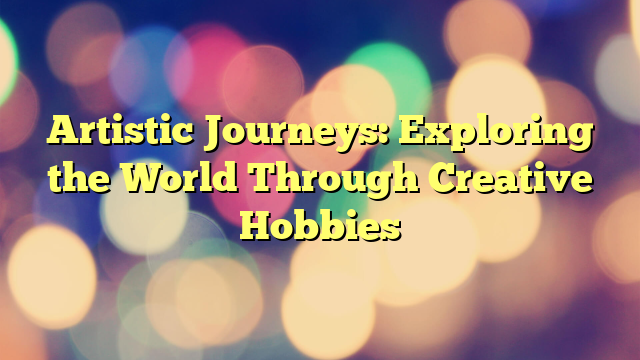Artistic Journeys: Exploring the World Through Creative Hobbies

In today’s fast-paced world, where technology dominates and our lives are constantly connected, it’s essential to find ways to disconnect and rejuvenate our souls. Engaging in creative hobbies is a wonderful way to achieve this, allowing us to explore the world through artistic journeys that bring joy, fulfillment, and a sense of discovery.
The Power of Creative Hobbies
Creativity knows no boundaries, and the benefits of engaging in artistic hobbies extend far beyond the finished product. Here are some reasons why exploring the world through creative hobbies can enrich your life:
1. Self-Expression and Personal Growth
Creative hobbies provide a platform for self-expression, allowing you to convey your thoughts, emotions, and experiences in a unique and meaningful way. Whether it’s painting, writing, playing a musical instrument, or photography, these activities tap into your innermost feelings, helping you understand yourself better and fostering personal growth.
- By engaging in painting, you can visually express your perception of the world. Whether you choose watercolors, acrylics, or colored pencils, each stroke of the brush or pencil reveals your unique interpretation of the world around you. You can explore different techniques, styles, and color palettes, allowing your creativity to flourish.
- Writing, on the other hand, provides an avenue to express your thoughts, emotions, and experiences through words. You can dive into storytelling, fiction, or non-fiction writing, creating captivating narratives that transport readers to different times, places, and perspectives. Through writing, you can explore your creativity and expand your horizons.
- Playing a musical instrument allows you to channel your emotions and connect with others through the universal language of music. Whether you’re strumming a guitar, playing the piano, or blowing into a saxophone, music enables self-expression and personal growth. It helps you develop discipline, patience, and a deeper understanding of rhythm and melody.
2. Stress Relief and Mental Well-being
Engaging in creative hobbies offers a much-needed escape from the stresses of everyday life. It allows you to immerse yourself in the present moment, providing a form of meditation that calms the mind and reduces anxiety. The therapeutic benefits of creative pursuits can enhance mental well-being, promoting a sense of tranquility, mindfulness, and overall happiness.
- Photography, for example, encourages you to explore new places and experiment with lighting and composition. Through your lens, you can capture the beauty and diversity of the world, immortalizing breathtaking landscapes, candid moments, or intricate details that would otherwise go unnoticed. This process allows you to focus on the present, find beauty in the ordinary, and appreciate the world around you.
- DIY crafts provide a hands-on experience that promotes mindfulness and reduces stress. Whether it’s knitting, woodworking, pottery, or jewelry-making, these crafts require focus and attention to detail. Engaging in these activities allows you to disconnect from the digital world and immerse yourself in the tactile experience of creating something with your own hands. The satisfaction of completing a DIY project can bring a sense of fulfillment and boost your overall well-being.
3. Building Confidence and Resilience
Exploring the world through creative hobbies helps build confidence and resilience. As you navigate the various challenges and obstacles that come with mastering a new skill, you develop perseverance and determination. Each small achievement boosts your confidence, empowering you to tackle more complex projects and take risks in other areas of life.
- Painting and drawing, for instance, require practice and patience. As you experiment with different techniques and styles, you may encounter obstacles along the way. However, with persistence and a growth mindset, you can overcome these challenges and witness your progress. This process not only builds confidence in your artistic abilities but also translates into other areas of life, where you’ll find yourself more willing to take on new challenges and embrace personal growth.
- Engaging in music and dance also fosters confidence and resilience. Learning to play an instrument or mastering dance moves requires dedication and perseverance. As you progress, you’ll gain a sense of accomplishment and the confidence to perform in front of others. These skills can be transferred to various aspects of your life, boosting your self-esteem and resilience in the face of adversity.
4. Connecting with Others
Creative hobbies create opportunities for connection and social interaction with like-minded individuals. Joining artistic communities, attending workshops, or participating in group activities allows you to share your passion, learn from others, and build meaningful relationships. These connections enrich your journey by exposing you to diverse perspectives, constructive feedback, and a sense of belonging.
- Painting and drawing classes, for example, provide a supportive environment where you can connect with fellow artists, exchange ideas, and receive feedback on your work. This sense of community fosters personal growth and allows you to learn from others’ experiences, expanding your artistic horizons.
- Music and dance, being inherently social activities, offer numerous opportunities to connect with others. Joining a band, choir, or dance group allows you to collaborate with fellow musicians or dancers, creating a sense of camaraderie and shared creativity. These connections not only enhance your artistic journey but also provide a support system and lifelong friendships.
Exploring the World Through Various Artistic Mediums
Now, let’s dive into some popular artistic mediums that provide exciting avenues for exploring the world and nurturing your creative spirit:
1. Painting and Drawing
Painting and drawing allow you to visually depict your perception of the world. Whether you prefer watercolors, acrylics, or colored pencils, you can capture landscapes, portraits, or abstract compositions. Each stroke of the brush or pencil reveals your unique interpretation of the world around you and allows you to explore different techniques, styles, and color palettes.
- With watercolors, you can create ethereal and translucent effects, capturing the delicate nuances of light and shadow. This medium is well-suited for landscape painting, as it allows you to convey the atmospheric qualities of a scene.
- Acrylics, on the other hand, offer versatility and vibrant colors. They dry quickly, allowing you to layer and experiment with different textures. Acrylic paints are ideal for both abstract and realistic styles, giving you the freedom to express your creativity.
- Colored pencils provide precision and control, enabling you to create intricate details and achieve a high level of realism. This medium is particularly suitable for portrait or still-life drawing, where capturing fine nuances is essential.
2. Photography
Photography is a powerful medium for capturing the beauty and diversity of the world. Through your lens, you can immortalize breathtaking landscapes, candid moments, or intricate details that would otherwise go unnoticed. Photography encourages you to explore new places, experiment with lighting and composition, and tell stories through images.
- Landscape photography allows you to showcase the grandeur of nature, from majestic mountains to tranquil seascapes. By playing with composition, lighting, and perspective, you can create captivating images that evoke a sense of awe and wonder.
- Street photography captures the essence of everyday life, documenting the unique stories and moments that unfold in urban environments. It requires a keen eye for details and the ability to anticipate and capture fleeting moments.
- Macro photography reveals the intricate beauty of small subjects, such as flowers, insects, or textures. By getting up close and personal, you can uncover a hidden world and showcase the delicate details that often go unnoticed.
3. Writing and Poetry
Writing and poetry provide a gateway to express your thoughts, emotions, and experiences through words. Dive into the world of storytelling, fiction, or non-fiction writing to create captivating narratives that transport readers to different times, places, and perspectives. Poetry, on the other hand, allows you to distill your emotions into evocative verses that explore the depths of the human experience.
- Fiction writing allows you to create entire worlds and characters, immersing readers in thrilling adventures or thought-provoking scenarios. Through your words, you can transport readers to faraway lands, introduce them to intriguing personalities, and challenge their perspectives.
- Non-fiction writing enables you to share your knowledge and expertise on a particular subject, whether it’s travel, history, or personal development. By researching and crafting informative articles, you can educate and inspire readers, sparking their curiosity and expanding their horizons.
- Poetry, with its rhythmic and evocative language, delves into the depths of human emotions and experiences. It allows you to express complex feelings in a condensed form, creating powerful imagery and inviting readers to contemplate life’s mysteries.
4. Music and Dance
Music and dance transcend language barriers, allowing you to communicate and connect with others on a profound level. Whether you play an instrument, sing, or embrace various dance styles, these art forms enable you to express yourself physically and emotionally. Engaging in music and dance fosters cultural appreciation, creativity, and a deep connection to rhythm and movement.
- Playing a musical instrument provides an outlet for self-expression and creativity. Whether you choose the piano, guitar, violin, or any other instrument, you can explore different genres, experiment with melodies, and compose your own music. Music allows you to tap into your emotions and convey them through sound, connecting with others on a universal level.
- Dance, with its diverse styles and techniques, encourages physical expression and storytelling. From ballet to hip-hop, each dance form has its unique language and movements. By learning and mastering different dance styles, you can communicate narratives, emotions, and cultural traditions through your body, fostering a sense of unity and appreciation for diversity.
5. DIY Crafts
Engaging in do-it-yourself (DIY) crafts opens up a world of possibilities for exploring your creativity across various mediums. Whether it’s knitting, woodworking, pottery, or jewelry-making, DIY crafts offer a hands-on experience, allowing you to create unique, personalized items. These crafts provide an opportunity to explore different materials, techniques, and styles while cultivating patience and attention to detail.
- Knitting allows you to create warm and cozy garments or intricate accessories. With a pair of needles and a ball of yarn, you can explore different knitting stitches, patterns, and colors. Knitting is not only a creative outlet but also a soothing and meditative activity that promotes relaxation and mindfulness.
- Woodworking provides the opportunity to shape and create functional objects from raw materials. From carving intricate designs to constructing furniture, woodworking allows you to explore the beauty of wood, learn new techniques, and create lasting pieces that showcase your craftsmanship.
- Pottery taps into the tactile experience of working with clay and allows you to shape and mold unique vessels, sculptures, or decorative items. By experimenting with different pottery techniques, glazes, and firing methods, you can create one-of-a-kind pieces that reflect your artistic vision.
- Jewelry-making combines creativity and craftsmanship, allowing you to design and create personalized accessories. From beading and wirework to metal stamping and soldering, there are numerous techniques to explore. Jewelry-making offers the opportunity to express your style and create wearable art.
Conclusion
Artistic journeys through creative hobbies invite us to explore the world in unique and profound ways. They provide an outlet for self-expression, promote personal growth, and offer an escape from the stresses of everyday life. Engaging in painting, photography, writing, music, dance, or DIY crafts allows us to connect with others, nurture our creativity, and embark on a fulfilling journey of exploration. So go ahead, unleash your imagination, and discover the world through the power of art.

